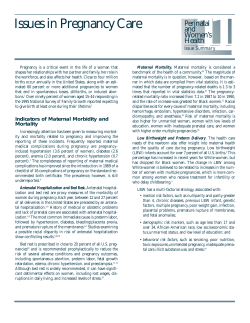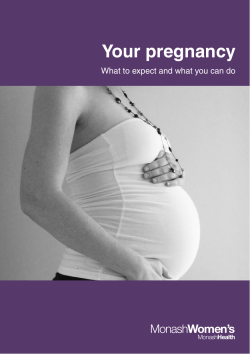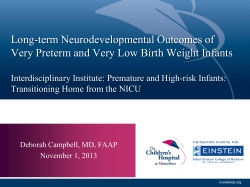
'Role of Early Second Trimester High Sensitivity Pregnancy Outcome'
JK SCIENCE ORIGINAL ARTICLE 'Role of Early Second Trimester High Sensitivity C-Reactive Protein for Prediction of Adverse Pregnancy Outcome' Archana J Dhok, Sangeeta Daf*, Kanchan Mohod , Satish Kumar Abstract A prospective cohort study was carried out to evaluate the role of early second trimester high sensitivity C - reactive protein for prediction of adverse pregnancy outcomes. Total 150 early second trimester primigravidae were analyzed for serum hsCRP level which was measured by immunoturbidimetry assay and followed till delivery. A statistically significant correlation was found between elevated serum hsCRP concentrations in early second trimester primigravidae and adverse pregnancy outcomes like preterm delivery and pregnancy induce hypertension (p<0.001). This study reveals that elevated serum hsCRP concentration observed in early second trimester primigravida could help to predict adverse maternal and fetal outcomes and if timely preventive prophylactic therapies are tried, would help to prevent morbidity and mortality due to pregnancy disorders. Key Words HsCRP, Pregnancy, Adverse Pregnancy Outcomes Introduction Pregnancy, childbirth and their consequences are still the leading cause of disease, disability and death amongst women of reproductive age in developing countries. Human pregnancies are associated with profound inflammatory changes during early phase (1), resulting in adverse pregnancy outcomes like premature rupture of membrane, hypertensive disorders of pregnancy, gestational diabetes mellitus, preterm labour, intrauterine growth retardation, low birth weight baby etc. Attempts are being made continuously for having screening tests with high sensitivity and positive predictive value so that timely preventive prophylactic therapies can be tried to avoid such pregnancy complications. Measurement of circulatory inflammatory markers may provide an alternative method of detecting women at high risk of delivery (2). C- reactive protein (CRP) is an acute phase reactant produced by the liver in response to the pro-inflammatory cytokines interleukin (IL-6) and tumor necrosis factor (TNF) (3). Since it has a relatively short half-life, the serum CRP level is dependent almost entirely on the rate of hepatic synthesis therefore; it is a sensitive index of systemic inflammation. The term high sensitivity CRP (hsCRP) refers to the lower detection limit of the assay procedure being used and is otherwise similar to routine CRP in structure and function. hsCRP has been suggested to provide better sensitivity in establishing inflammation than levels of CRP (4) and reflects ongoing inflammation and/or tissue damage much more accurately compared to other laboratory parameters of the acute-phase response(5). Recently, improved high sensitive and standardized quantitative assay in serum has allowed a re-evaluation of its potential as a diagnostic test. It can be use as an early marker of low grade inflammation and further help in detecting pathophysiological process early in pregnancy, so as to predict adverse pregnancy outcome and try preventive therapies well in time. Since there is paucity of data on maternal hsCRP level for predicting adverse pregnancy outcome, we proposed to evaluate the association, if any, between hsCRP in early second trimester primigravida and pregnancy outcome to find out the predictive potential of hsCRP for feto-maternal outcome. From the Deptt. of Biochemistry & *Obs & Gyane Mahatma Gandhi Institute of Medical Sciences, Sevagram (Wardha) Maharashtra Correspondence to : Dr. Satish Kumar, Professor, Biochemistry & Dy Coordinator, Bioinformatics Centre MGIMS, Sevagram (Wardha)MS. Vol. 13 No. 3, July - September 2011 www.jkscience.org 141 JK SCIENCE Material & Methods The present prospective study was carried out in the Department of Biochemistry in collaboration with the Department of Obstetrics and Gynaecology of Mahatma Gandhi Institute of Medical Sciences Sevagram for two years. Ethecal clearance was obtained from the Institutional Human Ethical committee. Total150 early second trimester primigravidae subjects at 16+2 (14-18) weeks of gestation attending obstetrics OPD for Ante natal checkups were included in this study. As increased Body Mass Index (BMI) interferes with serum hsCRP level, we included the subjects with normal BMI between 18-24 kg/m2. Detailed present, past and obstetric histories were obtained followed by general and systemic examinations. Subjects with history of hypertension, diabetes mellitus, heart diseases, acute or chronic infections history of oral contraceptive pill, addiction like smoking, tobacco chewing were excluded from this study. Blood sample each of about 3 ml was shared from the samples obtained for routine antenatal checkups. Blood samples were collected in plain bulbs. Sera were separated out by centrifuging at 3000 rpm for 10 min and stored separately at - 200C untill used for estimating high sensitivity C - reactive protein.Quantitative determination of high sensitivity C reactive protein (hsCRP). hsCRP was estimated in serum samples by Latex turbidimetry method using "SPINREACT" kit. Principle: Latex particles coated with specific antihuman CRP are agglutinated when mixed with samples containing CRP. The agglutination causes an absorbance change, dependent upon the CRP contents of the patient sample that can be quantified by comparison from a calibrator of known CRP concentration (6, 7). Sera of subjects were run in automatic analyzer (XL 300) and values of serum hsCRP were obtained. Reference values: Concentration of hsCRP below 3 mg / L is considered normal. Statistical Analysis The data was analyzed by SPSS 13.0. Proportion test (z test) and chi - square test (x2 test) were applied for statistical analysis. Results Amongst a total of 150 primigravidae only 139 subjects could be followed up till delivery, 11 who were lost to follow up were excluded. Amongst the maternal complications incidence of preterm delivery was 8.6% while that of oligohydramnios 4.3%, PROM 2.9% and PIH 2.2%. While amongst adverse fetal outcomes incidence of LBW was 17.26%, fetal distress 12.23% and IUGR 5.75 % (Table 1). When compared all adverse pregnancy outcomes in those having elevated hsCRP level 142 PIH and Preterm were statistically significant (p <0.01) suggesting positive correlation. However statistic significance was not observed between adverse fetal outcome and elevated hsCRP except for the fetal distress and IUD (p<0.05) (Table 1). Discussion Pregnancy associated complications are known to be often responsible for maternal, fetal and neonatal morbidity & mortality. Early detection followed by preventive therapy may decrease the complications and related feto-maternal risks. It could be possible only if the pregnant women prone to develop disorders are identified quite early. Recent literature identified adiposity as a key factor in low-grade chronic inflammation (8). Higher body mass index is associated with elevated CRP concentrations in adult men (9), non-pregnant women, and pregnant women (10). In our study, the association between hsCRP and adverse pregnancy outcome persisted after adjusting for pre-pregnancy body mass index and other known risk factors including maternal age, race/ethnicity, and smoking. To reduce errors we determined gestational age by LMP and Ultrasound. Different workers have taken different hs-CRP cut off and interpreted their findings. The varying range of hsCRP is because of different assays carried out by different workers to find out the titres of hsCRP in different populations. Additional studies have attempted to define normal reference ranges for hsCRP at various stages of normal gestation, delivery, and the puerperium (11, 12). We often get women with established disorder from 28 weeks of pregnancy or after that and maximum chances of abortions are in the first trimester, hence early second trimester was chosen for entry into the present study. First pregnancy is associated with a lower mean birth weight, increased rate of complications and raised perinatal mortality (13). Thus only primigravidae were included in the study to minimise adverse pregnancy outcomes.In this study, significant increase in hsCRP levels were observed in primigravidae who subsequently had preterm & preeclampsia (PIH) significant (p<0.01) compared to adverse pregnancy outcomes The association was stronger for cases that experienced spontaneous preterm delivery verses indicated preterm delivery. Increased inflammatory changes during pregnancy may be explained by different stimuli occurring at different phases of pregnancy such as implantation and monocyte/macrophage production stimulated by interleukin-6(IL-6), the necrotic process associated with placental ageing and the progressive increment in oestrogen level (2). It was found that bacterial products such as endotoxin stimulate decidual monocytes to www.jkscience.org Vol. 13 No.3, July-September 2011 JK SCIENCE Table 1. Co-Relation of Elevated Maternal Serum hs-CRP with Adverse Pregnancy Outcomes Adverse pregnancy outcomes PIH PROM Oligohydramnios Preterm No. cases Percentage (%) Concentration of p value hsCRP <3 mg/L >3mg/L 00 03 <0.01(HS) 04 00 >0.05(NS) 04 02 >0.05(NS) 03 09 <0.01(HS) 03 04 06 12 2.2 2.9 4.3 8.6 Oligohydramnios & Preterm 01 0.7 01 00 >0.05(NS) LBW Fetal distress 29 22 17.26 12.23 21 13 8 9 >0.05(NS) <0.05 (S) IUGR 08 5.75 6 2 >0.05(NS) IUD 01 0.71 0 1 <0.05(S) HS: Highly significant; S: Significant; NS: Non-significant produce cytokines which in turn stimulates arachidonic acid and then prostaglandin E2 (PGE2) and F2alpha act in a paracrine fashion to stimulate myometrium to contract and cause preterm labour and then preterm delivery (14). Waranuch P et al (2) reported very high level of CRP in early pregnancy which is associated with a preterm delivery. Hvilsom GB et al (15), found that high CRP level at the beginning of a pregnancy is associated with a nearly two fold increased risk of preterm delivery. Reron A et al (16) concluded that CRP is a useful marker of preterm delivery overtaking the result of vaginal culture. The results obtained in this study are comparable with these findings. Karimen L et al (17) in their study demonstrated that when Chlamydia trachomatis immunoglobulin G levels and CRP levels were present simultaneously the risk of preterm was four fold. In contrast Ghezzi F et al (18) observed that there was no statistically significant correlation between early second trimester elevated hsCRP and preterm delivery. There was no increase in hsCRP level in the subjects with Premature Rupture of Membrane (PROM). This supports the finding of Vitool L et al (19) that showed elevated CRP concentration in early pregnancy was significantly associated with increased risk of preterm but not with PROM. However Loukovaara MJ (20) studied serum CRP in preterm premature rupture of membranes and concluded that the increase in the highly sensitive CRP in PROM patients may reflect the presence of a subclinical inflammation. Preeclampsia is dreadful disorder of pregnancy. The etiology of endothelial dysfunction in preeclampsia is not known, but it has been postulated to be a part of an exaggerated maternal inflammatory response to pregnancy. Systemic maternal inflammatory response is responsible for endothelial dysfunction which leads to Vol. 13 No. 3, July - September 2011 abnormal vasomotor regulation, increased vascular permeability and thrombosis which are the features of preeclampsia. In the present study, PIH was reported to have strong correlation with hsCRP as all three cases that developed PIH had higher level of hsCRP, statistically significant ( p < 0.01). Batashki I et al (21) concluded that value of CRP was higher in women with preeclampsia compared to women with normal pregnancy. Hwang HS et al (1) showed that hsCRP level was positively correlated with pregnancy duration in healthy women and could be used as a severity marker in women with severe preeclampsia. Myles W et al (22) reported higher level of CRP compared with control in first trimester pregnancy who subsequently developed preeclampsia. The findings of our study are in agreement with these reports. Cytokines are released by vascular endothelium, leucocytes, macrophages and lymphocytes at the trophoblast - decidual interface elevated in preeclampsia. A cascade of markers, interleukins & TNF alpha. including CRP arise as a consequence of these reactions and elevation of their levels has been suggesting being the predictive of preeclampsia (23).The association between second-trimester C - reactive protein levels and subsequent preeclampsia identified in our univariable analysis supports the hypothesis that systemic inflammation was involved in the pathogenesis of preeclampsia (24). Moreover it is suggested that the prognosis of the disease could be predicted by evaluating hsCRP levels when severe preeclampsia is diagnosed. In this study the relation between hsCRP and adverse foetal outcomes like foetal distress, LBW IUGR and IUD was evaluated however no significant relation between fetal outcome and hsCRP was found except for distress, and IUD which was significant (p<0.05). Desouza JJ et al (25) studied CRP as a predictor of the fetal and www.jkscience.org 143 JK SCIENCE maternal infective mortality and also the fetal mortality. A significant association between raised CRP levels and low birth weight babies was found Tjoa ML et al (26) reported higher level of CRP during first trimester of pregnancy who later developed preeclampsia or delivered a growth-restricted baby. The strength of this study includes its prospective community based design which allowed us to evaluate temporality and comprehensive nature of follow up that minimized possible selection bias. Evidence of systemic inflammation existed many weeks before the clinical syndrome manifested. We evaluated serum hsCRP levels in early second trimester so as to avoid pregnancy related complications. The measurement of hsCRP has obvious economic advantage in comparison to assessment of cytokines. This study has certain limitations by its inability to conclude whether elevation of CRP levels occurred after conception or whether the elevated levels existed at baseline. As a result, it is impossible to determine whether systemic inflammation was induced by specific pregnancy-related factors or by factors that predated pregnancy. The simple non-invasive and cost effective nature of this test makes it still more effective as a predictive test. Conclusion Increased serum hsCRP levels in early second trimester primigravidae were significantly associated with adverse pregnancy outcome like Preterm delivery and Pregnancy Induced Hypertension (PIH) which envisages that this test could be of use as a simple predictive test in early pregnancies for Preterm delivery and PIH to References minimize maternal and fetal complications. 1. 2. 3. 4. 5. 6. 7. 144 Hwang HS, Kwon JY, Kim MA. et al. Maternal serum HSCRP in normal pregnancy in pre-eclampsia. Int J Gynaecol & Obst 2007; 98:105-09. Waranuch P, Matthew WG, Kaumudi JJ, et al. Plasma CRP in early pregnancy & preterm delivery. Am J Epidemiology 2005; 162(11): 1108-13. Yudkin JS, Stehouwer CD, Emeis JJ, et al. C - reactive protein in healthy subjects: Associations with obesity, insulin resistance, and endothelial dysfunction: A potential role for cytokines originating from adipose tissue? Arterioscler Thromb Vasc Biol 1999;19:972-78 Yu H Rifai N. High sensitivity C reactive protein and atherosclerosis: from theory to therapy. Clin Biochem 2000;8:601-10 Pepys MB, Baltz ML. Acute phase proteins with special reference to C - reactive protein and related proteins (pentaxins) and serum amyloid a protein. Adv Immunol 1983; 34:141-212. Koenig W, Sund M, Frohlich M, et al. C - reactive protein, a sensitive marker of inflammation, predicts future risk of coronary heart disease in initially healthy middle-aged men. Circulation 1999; 99:237-42. Pearson TA, Mensah GA, Alexander RW, et al. Markers of inflammation and cardiovascular disease: application to 8. 9. 10. 11. 12. 13. 14. 15. 16. 17. 18. 19. 20. 21. 22. 23. 24. 25. 26. www.jkscience.org clinical and public health practice. Circulation 2003; 107:499-511. Berg AH, Scherer PE. Adipose tissue, inflammation, and cardiovascular disease. Circ Res 2005; 96:939-49. Visser M, Bouter LM, Mc Quillan GM, et al. Elevated C reactive protein levels in overweight and obese adults. J Am Med Assoc 1999; 282:2131-35. Ramsay JE, Ferrell WR, Crawford L, et al. Maternal obesity is associated with dysregulation of metabolic, vascular and inflammatory pathway. J Clin Endocrinol Metab 2002; 87:4231-37. Keski-Nisula L, Kirkinen P, Ollikainen M, et al. C - reactive protein in uncomplicated parturients delivered by cesarean section. Acta Obstet Gynecol Scand 1997; 76:862-22. Nielsen FR, Bek KM, Rasmussen PE, et al. C - reactive protein during normal pregnancy. Eur J Obstet Gynaecol Reprod Biol 1990; 35:23-27. Pipkin FB. Maternal physiology in pregnancy. In: Chamberlain G, Steer P Turnbulls(eds.) Obstetrics, 3rd Edn. Churchill Livingstone. 2001.pp.71-91. Cox SM. Preterm labour. In: Cunningham FG, Steven L. Bloom, Leveno KJ (eds) Williams Obstetrics, 22nd Edn: Mc Grawhill. 2001.pp. 860. Hvilsom GB, Thorsen P, Jeune B. et al. C - reactive protein: a serological marker for preterm delivery? Acta Obstet Gynecol Scand 2002; 81:424-29. Reron A, Huras H, Szymik M. et al. C - reactive protein as a predictor of threatening preterm delivery. Neuro Endocrinol Lett 2004; 25(4):302-06. Karimen L, Anneli Pouta, Aini Bloigu, et al. Serum CRP and Chlamydia trachomatis Antibodies in preterm delivery. Obstet Gynecol 2005;106(1):73-80 Ghezzi F, Franchi M, Raio l, et al. Elevated amniotic fluid C- Reactive Protein at the time of genetic amniocentesis is a maker of preterm delivery. Am J Obstet Gynecol 2002; 186:268-73 Vitool L, Chunfang Qiu, Michelle AW, et al. Maternal serum C- reactive protein concentration in early pregnancy and subsequent risk of preterm delivery. Clinical Biochemistry 2007; 40(5): 330-35. Loukovaara MJ, Alfthan HV, Kurki MT. et al. Serum highly sensitive C reactive protein in preterm premature rupture of membrane. Eur J Obstet Gynecol Reprod Biol 2003; 110:26-28. Batashki I, Milchev N, Topalovska D. et al. C - reactive protein in women with preeclampsia. Akush Ginecol (soffia) 2006; 45(1):47-50. Myles W, Kettyle E, Sandler L. et al. Obesity and preeclampsia: the potential role of inflammation. Obstet Gynecol 2001; 98:757-62. Takacs P, Green KL, Nikaco A. et al. Increased vascular endothelial cell production of IL-6 in severe preeclampsia.Am J Obstet Gynecol 2003;188:740 Redman CW, Sacks GP, Sargent IL. et al. Preeclampsia: An excessive maternal inflammatory response to pregnancy. Am J Obstet Gynecol 1999; 180:499-506. Desouza J J, Perlmann T, Herman AAB. et al. CRP as a predictor of fetal and maternal infective morbidity and fetal mortality. S Afr Med J 1987; 71:690-92. Tjoa ML, van Vugt JM, Blankenstein MA. et al. Elevated C - reactive protein levels during first trimester of pregnancy are indicative of Preeclampsia and intrauterine growth restriction. J Reprod Immunol 2003; 59(1):29-37. Vol. 13 No.3, July-September 2011
© Copyright 2025





















